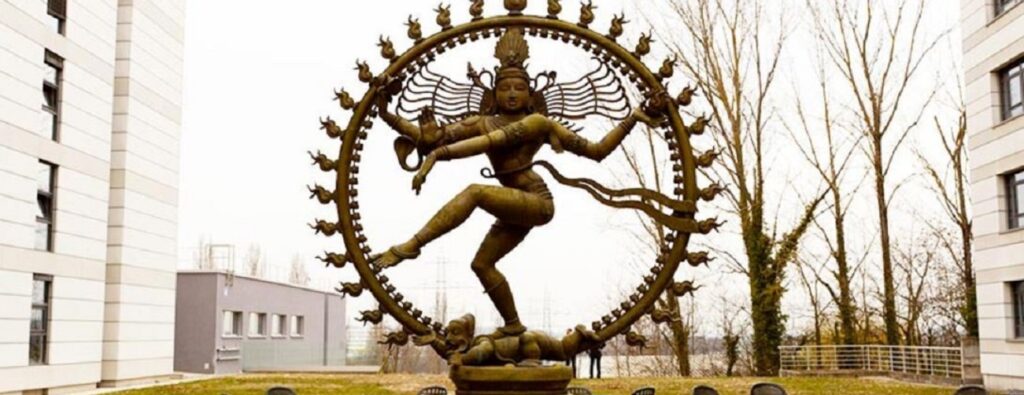Bronze Casting Art Photo Source: LAKSHMI SHARATH
Chola Bronze Sculptures
The earliest bronze statues in India were cast in the Indus Valley about 2300 BC, reaching an artistic peak during south India’s Chola Dynasty (9th to 13th centuries AD). The patronage of dynamic Chola rulers during this period sparked an unprecedented growth in philosophy, poetry, dance, temple architecture and fine art. The imperial Cholas utilized their prodigious wealth earned through their extensive conquests in building long-lasting stone temples and exquisite bronze sculptures. These bronze sculptures show classic grace, grandeur and perfect taste. The best example of this can be seen in the form of Nataraja – the Divine Dancer.

Photo Source: Detechter
Tamil Nadu has been a flourishing state for bronze sculpture, stonework and paintings. The history of architecture
and sculpture in Tamil Nadu begins with the Pallava Temple of the Dravidian Style. The ancient craft of panchaloha (bronze) casting is still flourishing today in a town called Swamimalai, located near Kumbakonam in Thanjavur district, and about 300 km from Chennai. The town on the river Cauvery is home to nearly 2,000 craftsmen engaged in making the world-famous bronze idols and statues [1]. The sculptors belong to the Vishwakarma community and have been engaged in lost wax method of bronze casting for generations.

Making Process
The lost wax method being an age old technique that has been in existence since Chola Empire of the 12th century and still remains unchanged. Swamimalai’s bronze idols are made using the ancient art of lost-wax casting technique which requires skilled sculptors with immense patience. The sculptors work with a soft dough of bee wax and gum resin shaping it into the desired shape. The process is similar to that of dhokra craft.
The making process of Bronze Idols goes through the following steps:
The sculptors work with a soft dough of bee wax and gum resin and the mixture is carefully molded into separate parts that comprise the sculpture and then lowered into a basin of cold water where it hardens instantly [2].
The hardened wax sculpture is then covered in several layers of wet mud [2]. This leaves the wax impression on the mud layer. The first layer of soft loamy soil of river Cauvery upon drying is enclosed in another layer of mud mixed with husk. Another week of sun-drying hardens the clay, preparing the clay mould (with the wax model inside) to bear high temperatures of molten metal [3]. The Molds are being tied with iron wires to avoid cracks during heating. These moulds cannot be reused and that makes each bronze idol unique. Two small holes to drain out molten wax and pour metal are made in this mould before sun-drying [3].
The sun-dried mud-covered wax idol is then baked in an earthen oven. This makes the wax melt, and the melted wax runs out of the chipped out hole, leaving a statue-shaped hole inside the clay mold [2]. This oven is a deep hole dug on the floor with a vessel to collect molten wax in [3]. Another hearth melts five metals (panchloha) — zinc, copper, tin, gold and silver — together [3]. The loss of half of the wax as fumes during baking gives the technique its name. Molten metal is then poured into the hollow that the melting of wax creates [3].
Once the metal cools, the clay mould is broken to reveal a rough version of the sculpture. After a little more chiseling in the details by hand and polishing, the brownish gold idol emerges.

Artisan is sculpting the basic structure of the body
using wax.
Pic Source: Dsource
Artisan applying clay on the wax model
Pic Source: Dsource

Product show is model half covered with clay
Pic Source: Dsource
Molten metal is being poured into the mold.
Pic Source: Dsource
The casting after breaking molds 
Sharp and unwanted surface are being chiseled.
Master Pieces – Sculptures
These bronze sculpture art pieces are made for prayer spaces at temple or home. Most sculptures are copies of those produced in the preceding centuries, especially the Chola era. Bronze sculptures are an important milestone in the history of metal sculptures of India. As the Bronze sculptures are long lasting, they are created for eternity! The sculpture of Bronzes immensely radiates a sense of immortality and powerfully reflects the fascination and mystery about the ancient cultures of Buddhism, Jainism and Hinduism.
For more metal sculptures art pieces check out our collections Shakti & Bhakti & 5 Elements Panchamahabhuta .
Source
- Bronzed Beauties, By Aruna Chandaraju, Deccan Herald, October 20, 2019, Retrieved from https://www.deccanherald.com/sunday-herald/sunday-herald-art-culture/bronzed-beauties-769364.html
- The Sensuous and the Sacred : Chola Bronzes from South India, By Vidya Dehejia, Richard H Davis, R Nagaswamy & Karen Pechilis Prentiss, American Federation of Arts. Retrieved from https://www.rarebooksocietyofindia.org/book_archive/196174216674_10150434296806675.pdf
- Gods of Heavy Metal, The Indian Express, July 15, 2018, Retrieved from https://indianexpress.com/article/express-sunday-eye/swamimalais-bronze-idols-made-using-the-lost-wax-casting-process-sit-pretty-in-local-and-foreign-lands-5258262/






